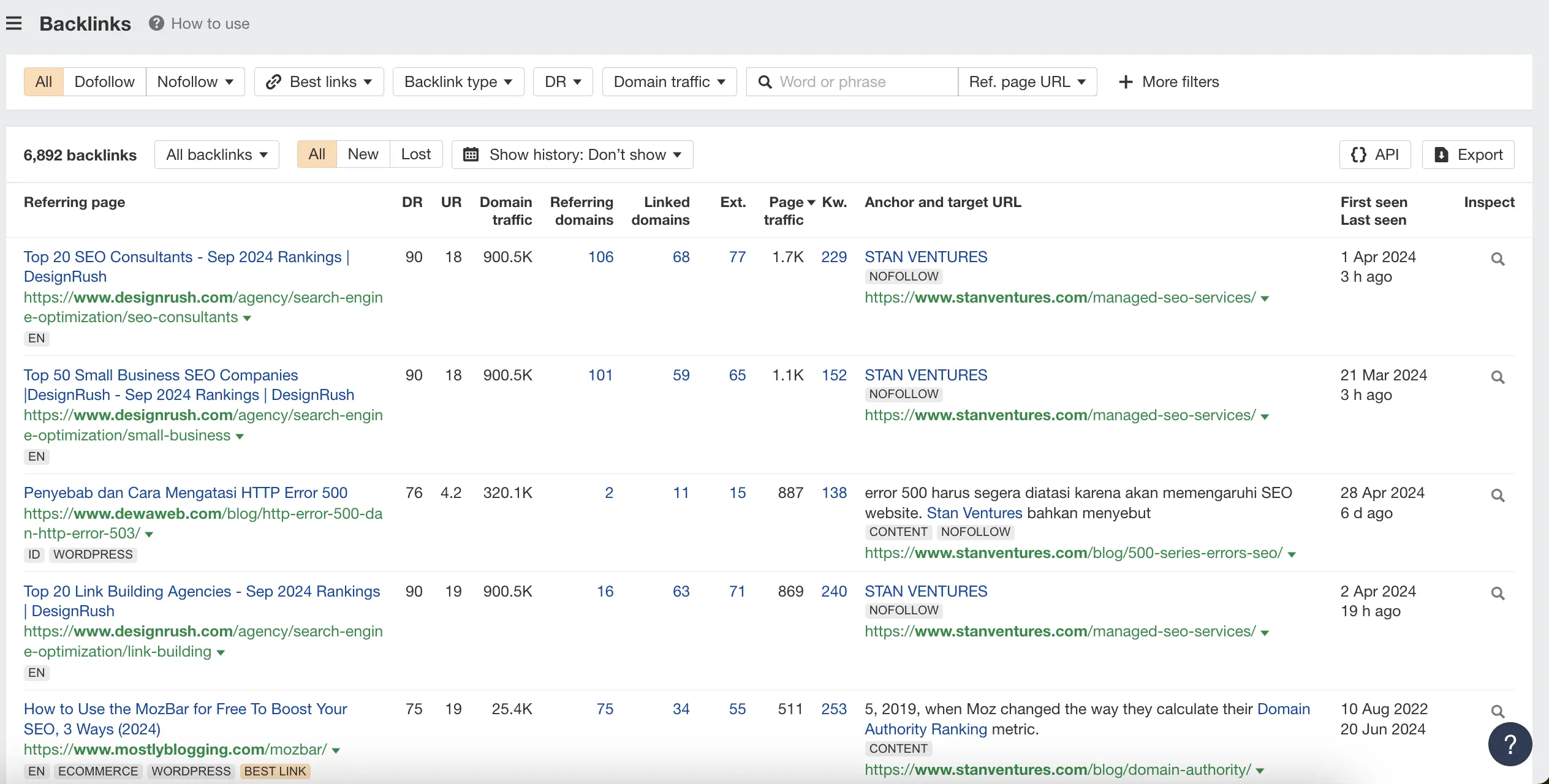Link-building outreach is falling short these days. Website owners are flooded with generic mass emails from people desperately asking for links.
In 2025, that approach falls flat.
What kind of site owner is going to respond to a poorly written request like this?
Definitely not the kind you want.
Even if you manage to get a reply, it’s likely from a low-quality site willing to sell links to anyone – not the type of partnership you’re after.
This is a real problem because building connections through outreach is key to getting those valuable links.
But here’s the fix. You need to focus on quality. Your emails should be specific and relevant, making them stand out from the spam-c cluttering inboxes.
In this article, we’ll help you understand how to do outreach for link building—including its process and types. Before getting started, it’s important to grasp how link building works for a more strategic approach.
Let’s break it down.
What is Link Building Outreach?
Link-building outreach is the strategic part of the backlinks-building process, where you reach out to website owners, bloggers, and influencers to form connections that benefit both sides.
Outreach plays a role in nearly every link-building approach, like:
- Guest posts
- Niche edits
- Linkable assets
- Broken link building
- Digital PR

The goal? To build a genuine reputation, boost your brand’s presence, or share valuable content with the right people.
A good outreach strategy isn’t just about getting backlinks – it’s about forming real relationships, getting mentions, and boosting credibility for everyone involved.
While email is still the most popular method, stepping up your game with social media, phone calls, or even direct mail can help create genuine, long-lasting partnerships.
Link-building outreach isn’t a walk in the park. It takes time and effort. But the good news? There are some solid strategies to make it smoother and more effective. Think of it like building connections; the better your content, the more people will want to link to it.
One surprising stat: blogging and content marketing can give you a 97% increase in indexed links because influencers love sharing great stuff. Creating valuable content is half the battle won.
So, Before You Begin: Review Your Content
Strong content is key to a successful link-building outreach. Convincing others to link back to your site is tough when the quality doesn’t stand out. If your content doesn’t feel ready, focus on improving it first before moving forward with outreach.
How to Do Outreach for Link Building: Step-by-Step Guide
Here is the step-by-step guide to help you get started with link-building outreach.
Step 1: Identify Your Outreach Targets
The first step in any link-building effort is to identify the right outreach targets.
This involves two key things:
- Finding relevant websites
- Identifying the right contacts on those websites
You want to focus on sites that publish content in your niche but aren’t direct competitors. Competitors likely won’t be interested in helping you with backlinks.
Targeting unrelated businesses is also a waste of time. Instead, go for websites that are loosely connected to your niche. For instance, a golf site could reach out to health and fitness blogs, lifestyle sites, or travel magazines.
When picking websites, check for signs they’re open to link building, like guest posts or links to competitors.
Watch Out for Spammy Sites
There are loads of spammy websites out there, and it’s best to steer clear of them. The worst-case scenario? Search engines might penalize you, tanking your rankings. Best case? They’ll ignore those links, wasting your time. Either way, it’s not worth the risk! Stick to quality sites for your link-building efforts.
There are plenty of ways to track down solid outreach targets. You should know where to look and how to spot the right opportunities.
Competitor Research
When it comes to competitor backlink research, you’re basically peeking into your competition’s already-used techniques to see which websites are linking to them. Why? Because if a site is already linking to your competitor, there’s a good shot they’ll be open to linking to you too.
Here’s the easy part:
Add your competitor’s URL into a tool like Ahrefs (or other SEO tools like Moz or SEMrush), and head straight to the “Backlinks” section.
That’s where you’ll see a list of all the sites, giving them a link. For a fresher perspective, filter it down to backlinks from the last 30 days.
This way, you get a clearer view of their latest link wins and can spot fresh opportunities for yourself.
It’s like checking out the competition’s recent highlights.

Link Intersect
To make competitor research more powerful, look for sites that link to several of your competitors but not to you.
If a site links to multiple competitors, it’s a good sign they might be open to linking to you, too.
SEO tools like Ahrefs offer this feature, called “Link Intersect,” found under the “More” menu. Just enter your competitors and your website to see where the overlap happens.
Next, you click “Show link opportunities,” and you’ll get a list of websites that link to your competitors but not to you. These are great potential targets for your outreach efforts.
View Websites in Your Niche
An easy way to find outreach targets is by compiling a list of niche websites.
You could do this by searching on Google and noting down sites that publish relevant content.
But a quicker option is using the competing domains feature on an SEO tool, which shows all the websites ranking for keywords similar to yours.
How It Works in Real Life
Let’s say you have a travel blog, and you’ve written a detailed guide on the best hiking trails. You want to pitch it to outdoor adventure sites.
Just hop into Ahrefs, search for outdoor adventure websites, and click on “competing domains.”
This will show you all the sites that share similar keywords with your target, giving you a list of potential outreach opportunities.
With these three methods you will have your list of outreach websites.
Step 2: Find the Right People on These Websites
After you’ve compiled your list of websites, the next step is finding the right contact emails.
If your list is long, using a tool like Hunter can help speed things up. Just upload a CSV with the website URLs, and Hunter will provide a list of email addresses. You can also use their domain search feature to find contacts for specific sites.
Either way, it’s much faster than searching each website individually for an email address.
You just have to makȩ sure you’re reaching out to the right person. It’s better to target specific email addresses with real names rather than generic ones like “admin” or “info.”
If you’re not sure which email to use, try searching for the name or address on Google to double-check.
Big websites often have several contacts, so picking the right person can make all the difference. You must usually aim for people in roles like:
- Content Manager
- Editor
- Blog Manager
- Founder
- Head of Marketing
The goal is to reach the person who handles content decisions.
For smaller websites and blogs, it’s fine to email the founder or head of marketing since they often manage content themselves.
For larger sites with dedicated content teams, it’s better to reach out to the content manager or editor.
If you’re having trouble finding the right contact through tools like Hunter, try searching LinkedIn for people at the company with relevant titles. You can either message them there or use Hunter to track down their email.
Step 3: Initiate the Contact
Once you’ve gathered your email list, it’s time to reach out.
There are two main approaches:
- Templated emails: For smaller blogs and websites, use a template that you can easily personalize. This helps you contact more sites quickly.
- Direct emails: For bigger, well-established sites, take the time to send personalized emails. These sites usually won’t respond to templates, but the effort is worth it for a quality backlink.
Template emails need a solid strategy to be effective. In the next sections, we’ll walk you through a simple approach to crafting one that gets results.
Step 4: Link Negotiation
The last step in link-building outreach is engaging with the prospect to close the deal for the link.
If they respond, there’s some level of interest, even if their reply isn’t super positive at first.
Many times, you can address their concerns with a thoughtful or creative follow-up.
Here’s how we handle common objectives.
Objection 1: “We Don’t Edit Old Articles”
This is a common response when asking for a link in an older post. A simple solution is to offer to write a guest post for their site instead.
Objection 2: “We Don’t Work for Free”
This usually means they expect something in return for the link. You can ask if there’s a way to make it work, and if you’re okay with paying for links, mention it upfront.
Objection 3: “We Charge $X for Links”
When a website asks for payment, you can either agree or try to negotiate for a better rate. Asking for a discount doesn’t hurt, and often, they’ll be open to adjusting the price.
Should you pay for backlinks? It’s not always a simple yes or no.
Whichever way you respond, you need to make sure that you always try to do so as quickly as possible.
At this stage, clear and friendly communication is key.
Building trust and a good rapport with the prospect will increase your chances of getting the link.
Here’s a quick checklist we follow:
- Keep your responses polite, even if the prospect seems a bit unfriendly.
- Avoid coming off as too pushy when asking for the link. That can be a turn-off.
- Always double-check the spelling of names to avoid any easy slip-ups.
- If you’re unsure about the tone of your email, try using a tool like Grammarly. It can help you ensure your message sounds right and catches any grammar or spelling mistakes.
Once you’ve reached an agreement with a website, it’s just a matter of waiting for the link to go live. Sometimes, it happens quickly, while other times, it can take weeks.
High-authority sites, for instance, often have detailed publishing processes that take a while to complete.
Though link-building outreach can be slow and comes with its fair share of rejections, it’s still a crucial part of any campaign.
Template Email Outreach Link Building Strategy
As we have explained in step 3, the two ways of initiating the contacts, we will now talk about the first one. Templated emails are messages sent to several sites at the same time.
If done wrong, they can come off as spammy and won’t get much traction. However, with a bit of personalization and targeting, you can increase your chances of getting a good response.
1. Segment your email lists
The first step is to be picky about who you reach out to. This makes sure your message is relevant to the recipient.
If your outreach list includes a wide range of websites from different niches, it’s smart to break it into smaller segments to keep your emails focused.
For instance, a skincare brand looking to build backlinks might have a list that includes both beauty blogs and wellness sites.
By splitting the list, they can tailor emails to each niche more effectively.
You can even go further by narrowing down the beauty blogs into categories like makeup, skincare routines, or anti-aging. The more you target, the better your chances of success.
Tools like Hunter or BuzzStream allow you to create email templates with personalized touches, such as adding names or website URLs, making your outreach feel more genuine.
2. Create Email Templates
When crafting emails, it’s important to be as specific as possible, even when contacting multiple websites at once. Here are a few things that can help:
- Personalize the details: Include the recipient’s name and website in each email. These can be auto-filled to save time.
- Introduce yourself: Let them know they’re talking to a real person, not an automated message.
- State your purpose clearly: Whether it’s for a guest post, a request for a link, or any other offer, make it clear from the start.
- Add credibility: Mention other websites that have accepted guest posts or linked to your content.
- Use different templates: Tailor your templates to each niche. For example, emails for a fitness blog will look different than ones for a food blog.
- Offer value: Highlight what’s in it for them, whether it’s sharing the post on social media, giving them a link in return, or even offering payment.
- Sign off professionally: A proper email signature makes your message more trustworthy.
As you send out more emails, track which approaches work best and save those templates for future outreach efforts.
3. Set Up the Email
The next step is to set up and schedule your outreach email. Tools like Hunter or BuzzStream make this process simple.
Start by picking a day and time. We usually send emails on weekday mornings in EDT, so they hit inboxes right at the start of the U.S. workday.
If you’re reaching out to websites in different time zones, adjust the timing accordingly.
For larger outreach lists, spread your emails out over several days. We aim for around 20 emails per day to keep things manageable.
Before hitting “send,” make sure to send a test email to yourself. This helps confirm everything, from formatting to personalized details, is working correctly. Poor formatting can make your emails look like mass spam, so it’s worth double-checking.
Once it all looks good, go ahead and schedule your emails!
Email Outreach Link Building Sample Templates
Here are a couple of email template examples that you can use for different types of outreach:
Guest Post Request Template for Link Building Outreach
Subject: Guest Post Contribution for [Website Name]
Hi [First Name],
I hope you’re doing well! I’ve been a fan of [Website Name] for a while, and I love the content you share, especially the post on [mention relevant article].
I wanted to reach out and see if you’d be open to a guest post contribution. I’ve got a few ideas that I think would resonate with your readers, like:
- [Idea 1]
- [Idea 2]
- [Idea 3]
I’d love to hear your thoughts on these topics or any suggestions you have in mind. I can promise the content will be high quality and provide value to your audience.
Looking forward to your feedback!
Best,
[Your Name]
[Your Website]
[Your Email Signature]
Link Request Template for Outreach
Subject: Quick Question About Your Post on [Website Name]
Hi [First Name],
I came across your article on [mention the article topic] and found it super informative. I noticed you mentioned [related topic] in your post, and I thought you might be interested in checking out our guide on [related content].
Here’s the link: [Insert URL]
I believe it would be a useful resource for your readers. Would you consider adding it to your article?
Thanks for considering, and I’d love to hear your thoughts.
Best,
[Your Name]
[Your Website]
[Your Email Signature]
Resource Link Request Template for Link Building Outreach
Subject: Suggestion for Your Resource Page
Hi [First Name],
I hope you’re doing well. I was browsing through your resource page on [mention page], and I noticed you provide a lot of valuable links for your audience.
I thought [your resource] could be a great addition to your list. It covers [topic] in-depth and might be helpful to your readers who are looking for more information on this subject.
Here’s the link for a quick look: [Insert URL]
Let me know if you’d be open to including it, and thanks for your time!
Best regards,
[Your Name]
[Your Website]
[Your Email Signature]
These templates can be personalized depending on your outreach goals and the recipient’s website.
Manual Outreach Link Building Tips & Tricks
Here are some helpful tips and tricks to make your manual outreach for link building more effective. These strategies can boost your chances of success and help you build meaningful connections.
#Tip 1: Prioritize Websites with High Authority
Not all websites are created equal when it comes to SEO value. The authority of the website you’re targeting is crucial for your link-building strategy. Websites with higher domain authority will pass on more SEO benefits to your website through backlinks.
Here’s how you can assess the authority of a website:
- Domain Authority (DA): Use tools like Moz or Ahrefs to check a website’s DA. Generally, a DA of 40+ is considered strong, but relevance to your niche is equally important.
- Traffic Volume: High-traffic websites are generally more authoritative and can offer more referral traffic. Check how much traffic the site receives using tools like SimilarWeb or SEMrush.
- Link Profile: A website’s link profile can give you an idea of its authority. Websites that already have backlinks from high-authority domains are typically better targets.
- Trustworthiness: Ensure that the site is legitimate active, and doesn’t engage in black-hat SEO practices. Avoid spammy or low-quality websites that could potentially harm your site’s reputation.
#Tip 2: Segment Your Outreach Targets
Once you’ve compiled a list of relevant, high-authority websites, it’s essential to segment your targets to tailor your outreach effectively. Not every website or individual will respond to the same pitch, so segmentation helps in customizing your approach for better results:
- Tier 1: High-Authority, Niche-Specific Websites – These are the top websites in your industry with a strong following and DA. These targets may require a more thoughtful and personalized approach since they receive a lot of outreach.
- Tier 2: Medium Authority, Niche-Adjacent Websites – These are websites with moderate DA but still highly relevant to your niche. They may not have as large a following as Tier 1 sites but are more likely to engage with personalized outreach.
- Tier 3: Bloggers, Small Websites, and Influencers – This group may consist of niche bloggers, micro-influencers, or smaller websites. While their authority might be lower, these targets are often more approachable and willing to collaborate.
By segmenting your outreach list, you can prioritize the most valuable targets and tailor your pitch accordingly.
#Tip 3: Leverage Social Media for Identification
In addition to using SEO tools and Google searches, social media platforms like Twitter, LinkedIn, and Facebook can be powerful resources for finding your target audience for outreach. Social platforms are home to communities of influencers, bloggers, and industry professionals who actively engage with content in your niche. Here’s how to use social media to your advantage:
- Twitter Lists: Create or follow Twitter lists that include influencers, journalists, or bloggers in your niche. This will help you stay up-to-date with relevant content and find opportunities for outreach.
- LinkedIn Networking: LinkedIn is a great place to connect with professionals, especially for B2B link-building efforts. Join groups, participate in discussions, and build relationships with people who run websites in your industry.
- Facebook Groups and Communities: Facebook has numerous niche groups where professionals and enthusiasts engage in content discussions. While links shared here might not directly influence SEO, these groups can help you connect with site owners who are open to content collaboration.
#Tip 4: Identify Broken Link Opportunities
While searching for target sites, keep an eye out for broken link opportunities. A broken link is a hyperlink on a website that no longer works because the destination page is missing. This presents an opportunity for you to reach out to the site owner and suggest your content as a replacement for the broken link. To identify broken link opportunities:
- Use Tools Like Check My Links: Chrome extensions like Check My Links can scan a webpage for broken links. Once identified, you can offer your content as a replacement.
- Research Competitor Sites: Scan your competitors’ backlinks to see if any are broken. This gives you a foot in the door to offer similar content from your site.
Broken link building is a more subtle form of outreach and often yields better results because it helps the site owner solve a problem while providing a relevant link back to your content. For a complete step-by-step approach to this tactic, check out broken link building guide.

#Tip 5: Analyze Audience Engagement
Beyond just checking metrics like DA and relevance, it’s essential to ensure the websites you’re targeting have an engaged audience. A backlink from a site with low engagement won’t drive much traffic or authority. Look for signs of engagement like:
- Active Comment Sections: Websites with active comment sections or user-generated discussions show that the audience is interacting with the content.
- Social Shares: Check if the website’s articles are being shared on social media. High engagement on platforms like Twitter or Facebook can mean more visibility for your content.
- Newsletter Subscribers: If a website boasts a large email newsletter following, getting a backlink in one of its articles could also lead to a shout-out in its newsletter, amplifying your content’s reach.
Hire Freelancers for Outreach Link Building Services
Outreach for link building can be time-consuming and challenging, especially when you’re juggling other responsibilities. If you’re looking to scale your efforts without sacrificing quality, hiring a freelancer can be a smart move.
Freelancers specialize in crafting personalized outreach strategies, building relationships, and securing high-quality backlinks. They can save you time, ensure better results, and let you focus on other aspects of your business.
Consider hiring a freelancer to handle your outreach and take your link-building campaign to the next level.








I love your blog.. very nice colors & theme. Did you create this website yourself? Plz reply back as I’m looking to create my own blog and would like to know wheere u got this from. thanks
Hi there, You have done an excellent job. I’ll definitely digg it and personally suggest to my friends.
I’m confident tey will be benefited from this website.
Quality articles orr reviews is the crucial to interest the
viewers to visit the website, that’s what tjis website is providing.
What’s Happening i’m nnew tto this, I stumbled upon this I’ve found It absolutely
helpful and it has heslped me out loads. I
hope too give a contribution & aid other users like its helped me.
Good job.
Hi there Dear, are you truly visiting this web page daily,
if so then you will without doubt get good experience.
Greate pieces. Keep writing such kind of info on your page.
Im really impressed by your site.
Hey there, You’ve performed an excellent job. I will certainly digg it and
for my part suggest to my friends. I’m confident they will be
benefited from this site.
Wow, incredible weblog layout! How lengthy have
you been running a blog for? you make blogging look easy.
The full glance of your site is fantastic, as neatly
as the content!
I could not refrain from commenting. Very well written!
It is remarkable, rather useful.
This is a fantastic and well-researched article on link-building outreach! The step-by-step guide and practical tips provide great value for anyone looking to improve their backlink strategy. Highly recommend reading it for anyone serious about link building outreach.
It is remarkable, it is a valuable piece